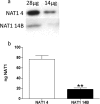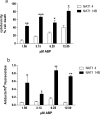Phenotype of the most common "slow acetylator" arylamine N-acetyltransferase 1 genetic variant (NAT1*14B) is substrate-dependent
- PMID: 22010219
- PMCID: PMC3250052
- DOI: 10.1124/dmd.111.041855
Phenotype of the most common "slow acetylator" arylamine N-acetyltransferase 1 genetic variant (NAT1*14B) is substrate-dependent
Abstract
Human arylamine N-acetyltransferase 1 (NAT1) is a phase II cytosolic enzyme responsible for the activation or deactivation of many arylamine compounds including pharmaceuticals and environmental carcinogens. NAT1 is highly polymorphic and has been associated with altered risk toward many cancers. NAT1*14B is characterized by a single nucleotide polymorphism in the coding region (rs4986782; 560G>A; R187Q). NAT1*14B is associated with higher frequency of smoking-induced lung cancer and is the most common "slow acetylator" arylamine NAT1 genetic variant. Previous studies have reported decreased N- and O-acetylation capacity and increased proteasomal degradation of NAT1 14B compared with the referent, NAT1 4. The current study is the first to investigate NAT1*14B expression using constructs that completely mimic NAT1 mRNA by including the 5'- and 3'-untranslated regions, together with the open reading frame of the referent, NAT1*4, or variant, NAT1*14B. Our results show that NAT1 14B is not simply associated with "slow acetylation." NAT1 14B-catalyzed acetylation phenotype is substrate-dependent, and NAT1 14B exhibits higher N- and O-acetylation catalytic efficiency as well as DNA adducts after exposure to the human carcinogen 4-aminobiphenyl.
Figures




Similar articles
-
Metabolic activation and deactivation of arylamine carcinogens by recombinant human NAT1 and polymorphic NAT2 acetyltransferases.Carcinogenesis. 1993 Aug;14(8):1633-8. doi: 10.1093/carcin/14.8.1633. Carcinogenesis. 1993. PMID: 8353847
-
Metabolic activation of N-hydroxy-2-aminofluorene and N-hydroxy-2-acetylaminofluorene by monomorphic N-acetyltransferase (NAT1) and polymorphic N-acetyltransferase (NAT2) in colon cytosols of Syrian hamsters congenic at the NAT2 locus.Cancer Res. 1993 Feb 1;53(3):509-14. Cancer Res. 1993. PMID: 8425184
-
Cloning, sequencing, and recombinant expression of NAT1, NAT2, and NAT3 derived from the C3H/HeJ (rapid) and A/HeJ (slow) acetylator inbred mouse: functional characterization of the activation and deactivation of aromatic amine carcinogens.Toxicol Appl Pharmacol. 1997 Feb;142(2):360-6. doi: 10.1006/taap.1996.8036. Toxicol Appl Pharmacol. 1997. PMID: 9070359
-
Molecular genetics and epidemiology of the NAT1 and NAT2 acetylation polymorphisms.Cancer Epidemiol Biomarkers Prev. 2000 Jan;9(1):29-42. Cancer Epidemiol Biomarkers Prev. 2000. PMID: 10667461 Review.
-
Arylamine N-acetyltransferases: structural and functional implications of polymorphisms.Toxicology. 2008 Dec 30;254(3):170-83. doi: 10.1016/j.tox.2008.08.022. Epub 2008 Sep 12. Toxicology. 2008. PMID: 18852012 Review.
Cited by
-
Effects of dose and human N-acetyltransferase 1 genetic polymorphism in benzidine metabolism and genotoxicity.Arch Toxicol. 2023 Jun;97(6):1765-1772. doi: 10.1007/s00204-023-03497-1. Epub 2023 Apr 25. Arch Toxicol. 2023. PMID: 37097310 Free PMC article.
-
560G>A (rs4986782) (R187Q) Single Nucleotide Polymorphism in Arylamine N-Acetyltransferase 1 Increases Affinity for the Aromatic Amine Carcinogens 4-Aminobiphenyl and N-Hydroxy-4-Aminobiphenyl: Implications for Cancer Risk Assessment.Front Pharmacol. 2022 Feb 22;13:820082. doi: 10.3389/fphar.2022.820082. eCollection 2022. Front Pharmacol. 2022. PMID: 35273499 Free PMC article.
-
Identification and characterization of potent, selective, and efficacious inhibitors of human arylamine N-acetyltransferase 1.Arch Toxicol. 2022 Feb;96(2):511-524. doi: 10.1007/s00204-021-03194-x. Epub 2021 Nov 16. Arch Toxicol. 2022. PMID: 34783865 Free PMC article.
-
Arylamine N-acetyltransferases: from drug metabolism and pharmacogenetics to drug discovery.Br J Pharmacol. 2014 Jun;171(11):2705-25. doi: 10.1111/bph.12598. Br J Pharmacol. 2014. PMID: 24467436 Free PMC article. Review.
-
Acetyl coenzyme A kinetic studies on N-acetylation of environmental carcinogens by human N-acetyltransferase 1 and its NAT1*14B variant.Front Pharmacol. 2022 Oct 28;13:931323. doi: 10.3389/fphar.2022.931323. eCollection 2022. Front Pharmacol. 2022. PMID: 36386142 Free PMC article.
References
-
- Adam PJ, Berry J, Loader JA, Tyson KL, Craggs G, Smith P, De Belin J, Steers G, Pezzella F, Sachsenmeir KF, et al. (2003) Arylamine N-acetyltransferase-1 is highly expressed in breast cancers and conveys enhanced growth and resistance to etoposide in vitro. Mol Cancer Res 1:826–835 - PubMed
-
- Ambrosone CB, Abrams SM, Gorlewska-Roberts K, Kadlubar FF. (2007) Hair dye use, meat intake, and tobacco exposure and presence of carcinogen-DNA adducts in exfoliated breast ductal epithelial cells. Arch Biochem Biophys 464:169–175 - PubMed
-
- Bell DA, Stephens EA, Castranio T, Umbach DM, Watson M, Deakin M, Elder J, Hendrickse C, Duncan H, Strange RC. (1995) Polyadenylation polymorphism in the acetyltransferase 1 gene (NAT1) increases risk of colorectal cancer. Cancer Res 55:3537–3542 - PubMed
-
- Bendaly J, Zhao S, Neale JR, Metry KJ, Doll MA, States JC, Pierce WM, Jr, Hein DW. (2007) 2-Amino-3,8-dimethylimidazo-[4,5-f]quinoxaline-induced DNA adduct formation and mutagenesis in DNA repair-deficient Chinese hamster ovary cells expressing human cytochrome P4501A1 and rapid or slow acetylator N-acetyltransferase 2. Cancer Epidemiol Biomarkers Prev 16, 1503–1509 - PMC - PubMed
Publication types
MeSH terms
Substances
Grants and funding
LinkOut - more resources
Full Text Sources

